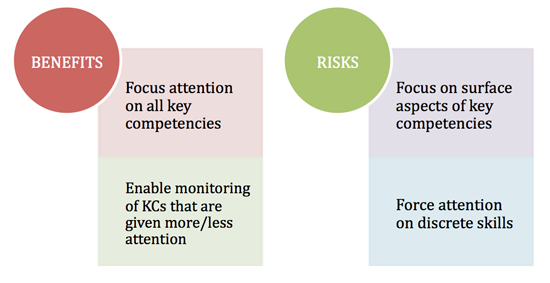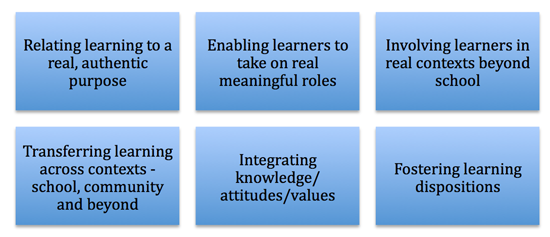A typical approach is to include a section about key competencies on existing unit/term planning templates. Some look like the example below:
Key competency focus
| How the key competency will be encouraged in this unit
|
| Thinking
|
|
| Relating to others
|
|
| Using language, symbols and text
|
|
| Managing self
|
|
| Participating and contributing
|
|
Benefits and risks of key competency planners
View a text version of this diagram.
Benefit: Focusing attention on all key competencies
Having sections for each key competency is helpful in reminding teachers to consider all of the key competencies – those they are most likely to focus on as well as those they are less inclined to focus on.
Benefit: Enable monitoring of key competencies that are given more/less attention
Templates that provide space for each key competency can be used to monitor those given the most, and least, attention across a year or more.
Risk: Focus on surface aspects of key competencies
Ensure to focus on deep, not just surface, aspects of key competencies.
There is a risk, however, that the individual sections – thinking, relating to others, etcetera – prompt merely surface attention to the key competencies. They don’t prompt attention to some of the deeper ideas about, for example:
- authentic contexts
- authentic roles
- authentic activities
- transfer between contexts
- application
- integration of knowledge/attitudes/values
- the role of dispositions.
Risk: Force attention back to discrete skills
Ensure attention to rich application in authentic contexts, rather than to discrete skills
E-competency/key competency planner example
In this talk, Kellie McRobert explains how she has developed an e-Learning framework she calls 'e-competencies' and how these have been aligned with the key competencies.
The 'planning placemat' introduced by Kellie, for example, supports the benefits outlined above.
It ensures that students are exposed to both ‘e’ and ‘key’ competencies, and prompts teachers to consider both sets of competencies.
When using resources such as the planning placemat, it is important to keep the benefits in mind and avoid the risk of moving away from the rich experiences in which key competencies occur, to the discrete skills that are more characteristic of the old essential skills. The risk is that we begin to think more about coverage of key competencies rather than about thequality of opportunities to develop key competencies.
So how might planners be developed to strengthen approaches to key competencies?
Possibilities
How can we develop planners as tools that support strengthening quality of students’ experience, rather than just monitoring coverage of key competencies?
Prompts
Include prompts, such as those outlined below, for teachers to consider and plan for. These prompts focus on the deeper ideas that sit across all of the competencies.
In this way, an activity could:
- be developed to link to a real purpose
- involve learning beyond the classroom
- connect with the kinds of attitudes and values the activity requires.
View a text version of this diagram.
Matrix
Rearrange the matrix format to allow for rich descriptions of activities or opportunities, rather than individual activities that are tied to one particular cell in a matrix.
|
| Learning focus/context/knowledge/understandings:
|
|---|
| Thinking
| Relating to others
| Using language, symbols and text
| Managing self
| Participating and contributing
|
| Authentic purpose
| Learning opportunities:
|
| Real, meaningful roles
|
| Authentic contexts within and beyond school
|
| Integrating knowledge/attitudes and values
|
| Fostering learning dispositions
|
Return to top


